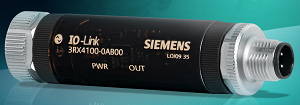Adapter connects standard sensors to IO-Link
Siemens has developed an adapter that makes it easy to integrate standard sensors into the IO-Link sensor/actuator communications network. This will allow most sensors to offer the benefits of IO-Link – such as integration in central diagnosis systems, and detecting errors – without modification.

The IP67-protected Simatic PX130C adapter provides signal conditioning and diagnostics functions and is aimed, in particular, at drives duties such as monitoring and controlling speed, recognising the direction of rotation, monitoring stoppages and slippages, and counting.
The adapter avoids the need for extra speed monitors and counter modules in the control cabinet, and for extra rotary encoders to detect speed and direction of rotation.
The signal-conditioning functions include A/D conversion, input inversion, and switching time measurements. The diagnostic functions include monitoring of connected sensors for wire breaks, short-circuits, and over- or undercurrents. It is also possible to specify whether the leading or trailing edge of a connected sensor should be detected.
The adapter can detect switching frequencies and counting processes up to 5kHz, making it suitable for open- and closed-loop control of agitators or oscillating conveyors.
The adapter can connect two binary proximity switches or a single analogue sensor to the control level. It has two inputs which can be set to pnp or npn, one of which is digital, the other being either analogue or digital. The analogue input can be set to 0–20mA, 4–20mA or 0–10V.





